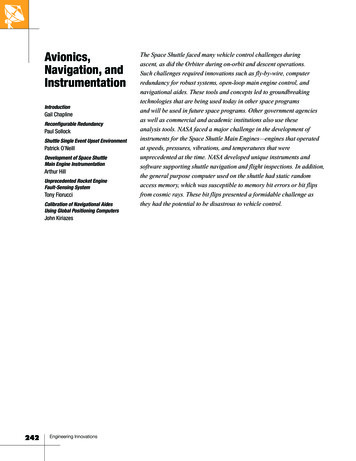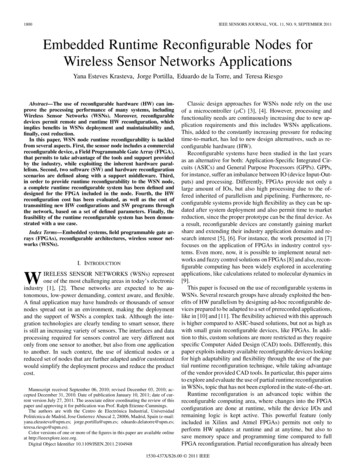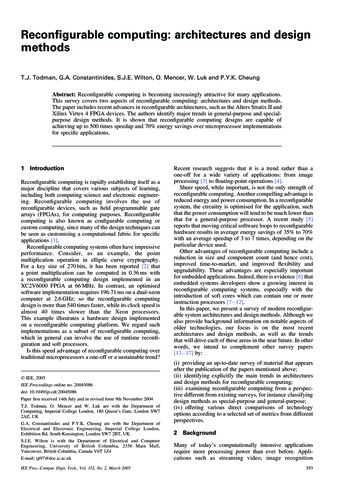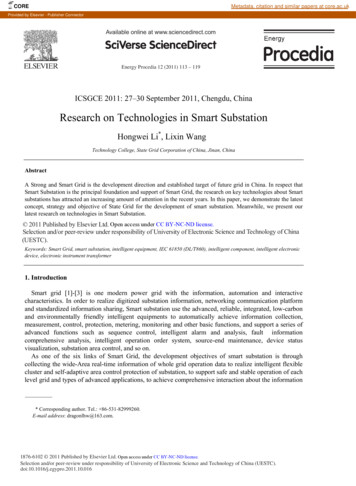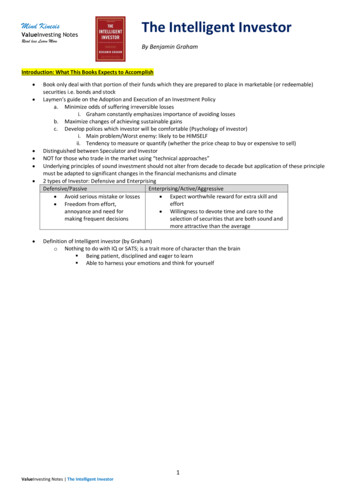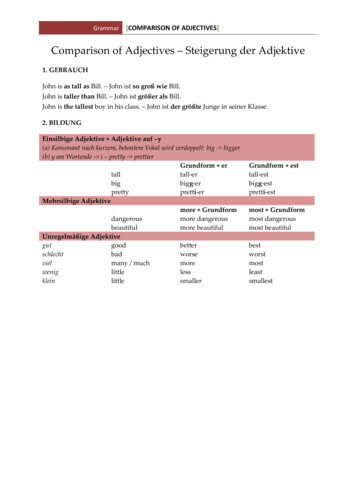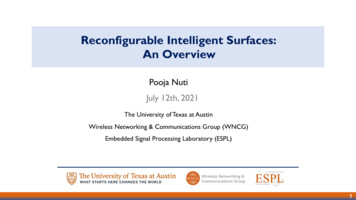
Transcription
Reconfigurable Intelligent Surfaces:An OverviewPooja NutiJuly 12th, 2021The University of Texas at AustinWireless Networking & Communications Group (WNCG)Embedded Signal Processing Laboratory (ESPL)1
Outline Motivation Introduction to RIS RIS Deployment Location Practical RIS Modeling Optimizing of RIS reflection coefficients Conclusion2
5G and Beyond Enabling Technologies Massive MIMO mmWave CommunicationEnable Internet of Everythingnetwork Current challenges regarding 5G High spatial resolution requires expensive hardware High frequencies (mmWave) Massive MIMO Ultra-Dense Networking3W. Saad, M. Bennis and M. Chen, "A Vision of 6G Wireless Systems: Applications, Trends, Technologies, and Open Research Problems," in IEEE Network, vol. 34, no. 3, pp. 134-142, May/June 2020
Smart Environments New IoE services being developed Virtual reality, telemedicine, brain-computer interfaces,and connected autonomous systems, etc. Transforming wireless systems into a self-sufficient,software-based, smart radio environment Smart radio environment Convert wireless channel into an optimization variable[1] M. Di Renzo et al., "Smart Radio Environments Empowered by Reconfigurable Intelligent Surfaces: How It Works, State of Research, and The Road Ahead," in IEEE Journal on Selected Areas inCommunications, vol. 38, no. 11, pp. 2450-2525, Nov. 2020[2] W. Saad, M. Bennis and M. Chen, "A Vision of 6G Wireless Systems: Applications, Trends, Technologies, and Open Research Problems," in IEEE Network, vol. 34, no. 3, pp. 134-142, May/June20204
Large ArraysMany names in literature regarding intelligent surfaces Active Arrays Large intelligent surfaces Reconfigurable reflectarrays Semi-passive arrays Reconfigurable intelligent surfaces Intelligent reflecting surfaces Software-controlled metasurfaces[1] E. Bjornson, Reconfigurable Intelligent Surfaces And Holographic Massive MIMO: Vision, Fundamentals, And Key Open Problems, IEEE ICC 2021 Tutorial5
Metamaterials/surfacesMetamaterial Initial metamaterials 3D synthetic materials engineered to achieveunique properties not found naturally Double-negative material 𝜖 0, 𝜇 0 , 𝜖 permittivity 𝜇 permeability Comprised of set of small scatterers in array toobtain a net behavior MetasurfacesMetasurface Metafilm or single-layer metamaterials Used in place of metamaterials Easier to implement Occupy less space Additional use cases: Controllable “smart” surfacesC. L. Holloway, E. F. Kuester, J. A. Gordon, J. O'Hara, J. Booth and D. R. Smith, "An Overview of the Theory and Applications of Metasurfaces: The Two-Dimensional Equivalents of Metamaterials," in IEEE Antennasand Propagation Magazine, vol. 54, no. 2, pp. 10-35, April 2012, doi: 10.1109/MAP.2012.6230714.7
RIS: Controllable Metasurfaces Comprised of subwavelength cells! ! ["# , ] sizeReflection coefficient ofscatterers vs scatterers’permeability RIS controller can change the electrical or magneticproperties of elements through the tunable component Reducing the amplitude Time delays Polarization Change General Implementation RIS Controller PIN diodes Varactor-diode based programmable metasurface Aim: Enabling large phase shifts from each cellwhile minimizing amplitude shifts Passive elements[1] Reconfigurable Intelligent Surfaces: A Signal Processing Perspective With Wireless Applications[2] C. L. Holloway, E. F. Kuester, J. A. Gordon, J. O'Hara, J. Booth and D. R. Smith, "An Overview of the Theory and Applications of Metasurfaces: The Two-Dimensional Equivalents of Metamaterials," in IEEE Antennas and Propagation Magazine, vol. 54, no. 2, pp.10-35, April 2012, doi: 10.1109/MAP.2012.6230714.8
Practical Modeling of the RISGeneral ModelingReflection coefficientAmplitude reflection coefficientPrior work mostly assumes ideal RIS (𝛽 1)Phase shift of m-th reflecting elementPractical ModelingImpedance for(n,m) RIS elementSource impedanceReflection coefficientAmplitude reflection coefficientPhase shift ofreflecting element[1] W. Tang et al., "MIMO Transmission Through Reconfigurable Intelligent Surface: System Design, Analysis, and Implementation," in IEEE Journal on Selected Areas in Communications, vol. 38, no. 11, pp. 2683-2699, Nov. 2020.9
RIS Location/Number of ElementsRIS should be deployed near BS based onFriis pathloss Pathloss on LOS path: Pathloss on NLOS pathConfigure number of RIS elements tocompensate for pathloss on path with RISFigures taken from ICC Workshop 2021 on RIS Presentation by Dinesh BharadiaM. Dunna, C. Zhang, D. Sievenpiper, and D. Bharadia, “ScatterMIMO: Enabling Virtual MIMO with Smart Surfaces,” in 2020 IEEE MobiCom, 2020, pp. 14.10
MISO RIS Optimization: SDP by CVX Solver Evaluate transmit beamformertransmission MRTusing maximum ratio Assumes an IRS controller which carries outcomputations Feedbackto BSStandard SDP Obtain higher rank solution then obtain rank-1 matrixcontaining optimized RIS phases CVX solver can be used to optimizeSDPin the standardQ. Wu and R. Zhang, “Intelligent reflecting surface enhanced wireless network: Joint active and passive beamforming design,” in 2018 IEEE Global Commun. Conf., 2018, pp. 1–6.11
MISO RIS Optimization: Fixed Point Iteration Semidefinite relaxation on the quadraticallyconstrained quadratic problem (QCQP) in Fixed point iteration used to solve Precoder designed by maximum ratiotransmission (MRT) after RIS phases areoptimizedReformulation of optimization problem Initialization: Update Rule:X. Yu, D. Xu, and R. Schober, “MISO wireless communication systems via intelligent reflecting surfaces : (invited paper),” in 2019 IEEE/CIC Intl. Conf. on Commun. China, 2019, pp. 735–740.12
MISO RIS Optimization: Fixed Point IterationX. Yu, D. Xu, and R. Schober, “MISO wireless communication systems via intelligent reflecting surfaces : (invited paper),” in 2019 IEEE/CIC Intl. Conf. on Commun. China, 2019, pp. 735–740.13
MIMO RIS Optimization: Alternating Optimization Narrowband case Optimization of with reflection coefficientsheld constant by waterfilling Optimization ofgiven fixed and Rewrite spectral efficiency as a function ofObtain more tractable problem byrewriting the capacity with thefollowing change: Exploit structure of problem to obtain optimalsolution to each subproblem.[1] S. Zhang and R. Zhang, "Capacity Characterization for Intelligent Reflecting Surface Aided MIMO Communication," in IEEE Journal on Selected Areas in Communications, vol. 38, no. 8, pp. 1823-1838, Aug. 2020.14
MIMO RIS Optimization: Alternating OptimizationHigh SNRLow SNRAchievable rate versus M[1] S. Zhang and R. Zhang, "Capacity Characterization for Intelligent Reflecting Surface Aided MIMO Communication," in IEEE Journal on Selected Areas in Communications, vol. 38, no. 8, pp. 1823-1838, Aug. 2020.15
MIMO RIS Optimization: Projected Gradient Ascent (PGA) Until convergence Optimization over RIS elements Optimization overOptimization Problem Comparison of PGA to AO methodOptimization variablesN. S. Perović, L. -N. Tran, M. Di Renzo and M. F. Flanagan, "Achievable Rate Optimization for MIMO Systems With ReconfigurableIntelligent Surfaces," in IEEE Transactions on Wireless Communications, vol. 20, no. 6, pp. 3865-3882, June 2021, doi:10.1109/TWC.2021.3054121.16
MISO RIS Channel Estimation Stage 1: Uplink Channel Estimate time: LS Estimate of each channel Binary setting for each RIS element ON/OFF control Stage 2: Downlink Active/Passive beamforming design Active beamforming from BS designed using maximum ratio transmission (MRT) Optimal: Passive beamforming designed by SDR-based solution using CVX Suboptimal: Passive beamforming with closed-form solution for RIS phase shiftsD. Mishra and H. Johansson, "Channel Estimation and Low-complexity Beamforming Design for Passive Intelligent Surface Assisted MISO Wireless Energy Transfer," ICASSP 2019 - 2019 IEEE International Conference on Acoustics,Speech and Signal Processing (ICASSP), 2019, pp. 4659-4663.17
RIS Channel EstimationPerformance of proposed least squaredestimator for different SNRSRIS size needed to reduce active array size atBSD. Mishra and H. Johansson, "Channel Estimation and Low-complexity Beamforming Design for Passive Intelligent Surface Assisted MISO Wireless Energy Transfer," ICASSP 2019 - 2019 IEEE International Conference on Acoustics,Speech and Signal Processing (ICASSP), 2019, pp. 4659-4663.19
Some RIS Use Cases Physical layer security IRS to enhance secrecy rate of wireless networks Wireless Power Transfer Deploying RIS in vicinity of IoT devices to improve the received power levelof IoT devices mmWave/terahertz Communications Improve the channel conditions of the mmWave MIMO channel20
[1] S. Zhang and R. Zhang, "Capacity Characterization for Intelligent Reflecting Surface Aided MIMO Communication," in IEEE Journal on Selected Areas in
